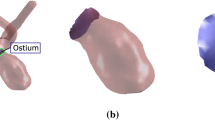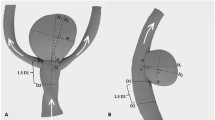Abstract
Shape irregularities of intracranial aneurysms may indicate an increased risk of rupture. To quantify morphological differences, Fourier analysis of the shape of intracranial aneurysms was introduced. We compared the morphology of 45 unruptured (UIA) and 46 ruptured intracranial aneurysms (RIA) in 70 consecutive patients on the basis of 3D-rotational angiography. Fourier analysis, coefficient of roundness and qualitative shape assessment were determined for each aneurysm. Morphometric analysis revealed significantly smaller coefficient of roundness (P<0.02) and higher values for Fourier amplitudes numbers 2, 3 and 7 (P<0.01) in the RIA group, indicating more complex and irregular morphology in RIA. Qualitative assessment from 3D-reconstructions showed surface irregularities in 78% of RIA and 42% of UIA (P<0.05). Our data have shown significant differences in shape between RIA and UIA, and further developments of Fourier analysis may provide an objective factor for the assessment of the risk of rupture.


Similar content being viewed by others
Notes
Values for the coefficient of roundness range from 0 to 1, a value of 1 represents a perfect circle.
References
Crompton MR (1966) Mechanism of growth and rupture in cerebral berry aneurysms. BMJ 1:1138–1142
McCormick WF, Acosta-Rua GJ (1970) The size of intracranial sacular aneurysms. An autopsy study. J Neurosurg 33:422–472
Hademenos GJ, Massoud TF, Turjman F, Sayre JW (1998) Anatomical and morphological factors correlating with rupture of intracranial aneurysms in patients referred for endovascular treatment. Neuroradiology 40:755–760
Ujiie H, Tamano Y, Sasaki K, Hoki T (2001) Is the aspect ratio a reliable index for predicting the rupture of a saccular aneurysm?. Neurosurgery 48:495–503
Nafe R, Kaloutsi V, Choritz H, Georgii A (1992) Elliptic Fourier analysis of megakaryocyte nuclei in chronic myeloproliferative disorders. Anal Quant Cytol Histol 14:391–397
Nafe R, Schlote W, Schneider B (2000) Shape analysis of tumor cell nuclei in ependymomas by means of Fourier analysis. Anal Quant Cytol Histol 22:475–482
Hahn E, Wild P, Hermanns U, Sebbel P, Glockshuber R, Haner M, Taschner N, Burkhard P, Aebi U, Muller SA (2002) Exploring the 3D molecular architecture of Escherichia coli type 1 pili. J Mol Biol 323:845–857
Keller P, van Saarloos P (1997) Fourier transformation of corneal topography data. Aust N Z J Ophthalmol 25 Suppl 1:53–55
Morio S, Baba N, Takabayashi K, Toyama Y, Oh H, Yoshida S, Nagano T (1993) The crystal structure of specific granules in human eosinophils studied by thin sectioning and deep-etching with the aid of Fourier transformation. J Electron Microsc (Tokyo) 42:172–177
Ostrowski K, Dziedzic-Goclawska A, Strojny P, Grzesik W, Kieler J, Christensen B, Mareel M (1986) Fourier analysis of the cell shape of paired human urothelial cell lines of the same origin but of different grades of transformation. Histochemistry 84:323–328
Kieler J, Ostrowski K, Strojny P, Rozycka M, Dziedzic-Goclawska A, Bulski W (1984) Fourier analysis of the shape of normal and transformed epithelial cells derived from human transitional epithelium. Histochemistry 81:119–128
Bederson JB, Awad IA, Wiebers DO, Piepgras D, Haley EC Jr, Brott T, Hademenos G, Chyatte D, Rosenwasser R, Caroselli C (2000) Recommendations for the management of patients with unruptured intracranial aneurysms: a statement for healthcare professionals from the Stroke Council of the American Heart Association. Stroke 31:2742–2750
Hop JW, Rinkel GJ, Algra A, van Gijn J (1997) Case-fatality rates and functional outcome after subarachnoid hemorrhage: a systematic review. Stroke 28:660–664
Hop JW, Rinkel GJ, Algra A, van Gijn J (1998) Quality of life in patients and partners after aneurysmal subarachnoid hemorrhage. Stroke 29:798–804
Whisnant JP, Sacco SE, O‘Fallon WM, Fode NC, Sundt TM Jr (1993) Referral bias in aneurismal subarachnoid hemorrhage. J Neurosurg 78:726–732
Asari S, Ohmoto T (1993) Natural history and risk factors of unruptured cerebral aneurysms. Clin Neurol Neurosurg 95:205–214
Sampei T, Mizuno M, Nakajima S (1991) Clinical study of growing up aneurysms: report of 25 cases. Neurol Surg 19:825–830
Wiebers DO, Whisnant JP, O‘Fallon WM (1981) The natural history of unruptured intracranial aneurysms. N Engl J Med 304:696–698
Beck J, Rohde S, el Beltagy M, Zimmermann M, Berkefeld J, Seifert V, Raabe A (2003) Difference in configuration of ruptured and unruptured intracranial aneurysms determined by biplanar digital subtraction angiography. Acta Neurochir (Wien) 45:861–865
Juvela S, Porras M, Heiskanen O (1993) Natural history of unruptured intracranial aneurysms: a long-term follow-up study. J Neurosurg 79:174–182
Kassell NF, Torner JC (1983) Size of intracranial aneurysms. Neurosurgery 12:291–297
Rosenorn J, Eskesen V (1993) Does a safe size-limit exist for unruptured intracranial aneurysms. Acta Neurochir (Wien) 121:113–118
Winn HR, Almaani WS, Berga SL, Jane JA, Richardson AE (1983) The long-term outcome in patients with multiple aneurysms. Incidence of late hemorrhage and implications for treatment of incidental aneurysms. J Neurosurg 59:642–651
International Study of Unruptured Intracranial Aneurysms Investigators (2003) Unruptured intracranial aneurysms: natural history, clinical outcome, and risks of surgical and endovascular treatment. Lancet 362:103–110
Wiebers DO, Whisnant JP, Sundt TM Jr, O’Fallon WM (1987) Intracranial aneurysm size and potential for rupture. (Letter) J Neurosurg 67:476
Kataoka K, Taneda M, Asai T, Kinishita A, Ito M, Kuroda R (1999) Structural fragility and inflammatory response of ruptured cerebral aneurysms. A comparative study between ruptured and unruptured cerebral aneurysms. Stroke 30:1396–1401
Kataoka K, Taneda M, Asai T, Yamada Y (2000) Difference in nature of ruptured and unruptured cerebral aneurysms (Letter). Lancet 355:203
Forget TR, Benitez R, Veznedaroglu E, Sharan A, Mitchell W, Silva M, Rosenwasser RH (2001) A review of size and location of ruptured intracranial aneurysms. Neurosurgery 49:1322–1326
Burleson AC, Strother CM, Turitto VT (1995) Computer modelling of intracranial saccular and lateral aneurysms for the study of their hemodynamics [see comments]. Neurosurgery 37:774–782
Kyriacou SK, Humphrey JD (1996) Influence of size, shape and properties on the mechanics of axisymmetric saccular aneurysms. J Biomech 29:1015–1022
Author information
Authors and Affiliations
Corresponding author
Rights and permissions
About this article
Cite this article
Rohde, S., Lahmann, K., Beck, J. et al. Fourier analysis of intracranial aneurysms: towards an objective and quantitative evaluation of the shape of aneurysms. Neuroradiology 47, 121–126 (2005). https://doi.org/10.1007/s00234-004-1324-x
Received:
Accepted:
Published:
Issue Date:
DOI: https://doi.org/10.1007/s00234-004-1324-x




